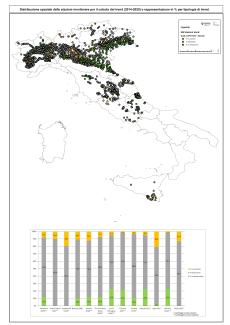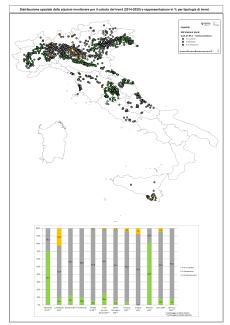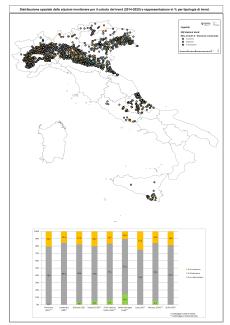Panel 1
Giancarlo De Gironimo, Marilena Insolvibile, Marco Marcaccio, Massimo Peleggi
Chemical monitoring of groundwater bodies during the period 2018–2020 revealed that the most critical anthropogenic substances on a national scale for chemical status are nitrates and trichloromethane. Among the various substances of potential natural origin present in groundwater bodies, electrical conductivity—related to the presence of chlorides—stands out as an excellent indicator of groundwater salinization. This salinization can stem from marine origins in coastal aquifers or from deep fossil waters.
Between 2014 and 2020, nitrate concentrations remained stable in 78.8% of the monitoring stations, decreased in 11.8%, and increased in the remaining 9.4%. The regions of Abruzzo and Emilia-Romagna reported the highest percentages of stations with decreasing trends (22.8%), while Lazio recorded the highest percentage of stations with increasing trends (20.6%).
Trichloromethane concentrations were stationary in 72.6% of the stations, showed a decreasing trend in 24.9%, and an increasing trend in only 2.5%. High percentages of stations with decreasing trends were observed in Marche (81.4%) and Piedmont (70.7%).
Electrical conductivity trends were stationary in 78.6% of the stations, decreasing in 4.6%, and increasing in the remaining 16.8%. Emilia-Romagna recorded the highest value for decreasing trends (14.5%), while Lazio had the highest percentage of increasing trends (25%).
Chemical substances present in groundwater characterize its chemistry and may impose limitations on resource use. The natural hydrogeochemical evolution of groundwater, from infiltration zones in the subsurface to its coming to daylight—such as in resurgent areas or in wells in the plains—involves a progressive and natural enrichment of chemical substances through interaction with the solid matrix of the aquifer.
However, many other chemical substances frequently found in groundwater are of anthropogenic origin. In this context, it is essential to distinguish substances of natural origin (BRIDGE, 2007; SNPA, 2018) from those resulting from anthropogenic pressures.
The European Directives 2000/60/EC and 2006/118/EC establish groundwater quality standards for pesticides and nitrates but delegate Member States to define threshold values for other chemical substances. In Italy, threshold values for groundwater quality were established in Legislative Decree No. 30/09 and subsequently amended in the Ministerial Decree of July 6, 2016, which simultaneously updated Legislative Decree No. 152/06.
The legislation mandates the evaluation of upward and reversal trends of pollutants in groundwater to assess the chemical status of groundwater bodies.
This indicator represents the chemical substances identified during the 2018–2020 monitoring by ARPA/APPA, considering the threshold values and quality standards outlined in Tables 2 and 3 of the Ministerial Decree of July 6, 2016, and distinguishing between anthropogenic substances and those of potential natural origin.
To represent anthropogenic and potentially natural-origin chemical substances monitored in groundwater by different Regions and Autonomous Provinces, as per the Environmental Ministry Decree of July 6, 2016. To quantify the number of monitoring stations where quality standards or threshold values set by regulations are exceeded for one or more substances. To identify critical substances affecting the good chemical status at the regional scale, including assessing anthropogenic impacts on groundwater. To highlight significant and long-lasting upward trends for some chemical substances of anthropogenic and potentially natural origin that regions and autonomous provinces frequently observe exceeding regulatory limits, as referenced in the Environmental Ministry Decree of July 6, 2016.
- Directive 2000/60/EC
- Directive 2006/118/EC
- Directive 2014/80/EU
- Legislative Decree No. 152/06
- Legislative Decree No. 30/09
- Environmental Ministry Decree of July 6, 2016
The objective of Directive 2000/60/EC is to promote and implement sustainable policies for the use and protection of surface and groundwater, contributing to safeguarding and improving environmental quality and ensuring rational use of natural resources. The environmental objective for groundwater bodies is achieving good status in both quantitative and chemical terms.
The Groundwater Directive 2006/118/EC, concerning "Protection of Groundwater from Pollution and Deterioration," along with Legislative Decree No. 30/09 and the Environmental Ministry Decree of July 6, 2016 (which amend Legislative Decree No. 152/06), outlines quality standards for certain chemicals and threshold values for others, necessary for assessing the good chemical status of groundwater.
Exceeding the annual average of quality standards or threshold values at any monitoring point may indicate a risk of failing to meet one or more conditions related to good chemical status for groundwater, as defined in Article 4, Section 2(c), Points 1, 2, and 3 of Legislative Decree No. 30/09.
The Environmental Ministry Decree of July 6, 2016, also incorporates Directive 2014/80/EU and amends Annex 1 Part III of Legislative Decree No. 152/06, emphasizing the importance and obligation of defining natural background levels for chemical substances in each groundwater body. This is crucial for accurately identifying anthropogenic impacts and critical substances for achieving the environmental objectives of groundwater bodies.
Groundwater monitoring is also structured to detect significant and long-lasting upward trends in pollutant concentrations.
Panel 2
BRIDGE (2007) Background cRiteria for the IDentification of Groundwater Thresholds. Project co-funded by the European Commission within the Sixth Framework Programme (2002-2006). http://nfp-at.eionet.europa.eu/irc/eionet-circle/bridge/info/data/en/index.htm. Ultimo accesso ottobre 2019 Guidance on groundwater status and trend assessment common implementation strategy for the Water Framework Directive (2000/60/EC), Guidance document no. 18. Technical report - 2009 – 026. ISBN 978-92-79-11374-1 ISPRA, 2014. “Progettazione di reti e programmi di monitoraggio delle acque ai sensi del D.Lgs. 152/2006 e relativi decreti attuativi”. Manuali e Linee Guida 116/2014. ISBN 978-88-448-0677-4 ISPRA, 2017. “Linee guida per la valutazione delle tendenze ascendenti e d’inversione degli inquinanti nelle acque sotterranee (DM 6 luglio 2016)”. Manuali e Linee guida 161/2017. ISBN 978-88-448-0844-0 SNPA, 2018. Linea Guida per la determinazione dei valori di fondo per i suoli e per le acque sotterranee. Linee Guida SNPA 8/2018. ISBN 978-88-448-0880-8 ISPRA, Annuario dei dati ambientali, edizione 2021
The lack of definition of the natural origin of various inorganic substances or metals (natural background values), when present in concentrations exceeding threshold values, may lead to potential overestimation of the number of monitoring stations showing exceedances due to natural causes rather than anthropogenic impact. To address this, the indicator presents a separate representation of anthropogenic substances and those of possible natural origin.
This distinction ensures that potential overestimation of stations with exceedances is limited to the representation of naturally occurring substances and does not affect anthropogenic substances.
Trend calculations will gain greater statistical robustness and spatial coverage as data for at least 8 years, as recommended by ISPRA Guidelines 161/2017, become progressively available. To consistently compare significant and long-lasting upward trends in contaminants, only operational monitoring stations should be selected for different regions.
A greater detail in the representation of the indicator regarding the natural origin of the chemicals will be provided following the determination of the natural background by the autonomous regions and provinces for the different water bodies and related monitoring stations. This will allow with certainty to associate an exceedance of the threshold values with a anthropogenic activity and not to a natural condition of the aquifer.
Data quality assessment
ARPA/APPA (Regional and Autonomous Provincial Environmental Protection Agencies)
http://www.sintai.isprambiente.it/faces/public/SOE/index.xhtml (con credenziali)
Regional - Provincial
2014-2020
Indicator assessment
Chemical monitoring of groundwater is conducted periodically by measuring the concentration of various chemical substances in water samples collected from monitoring stations (wells or springs). The goal is to identify the presence of pollutants and/or their trends over time. The substances analyzed in each station depend on the aquifer's hydrogeological characteristics and the anthropogenic pressures it is exposed to.
The monitoring data used for this indicator come from the SOE/EIONET data flow, transmitted annually by ARPA/APPA. The Environmental Ministry Decree of July 6, 2016, in Tables 2 and 3, specifies quality standards and threshold values that must not be exceeded as an annual average at each monitoring point.
For each identified chemical substance, the annual average concentration was calculated for each monitoring station, adhering to the calculation criteria outlined in Annex 3 of Legislative Decree No. 30/09 and the Environmental Ministry Decree of July 6, 2016. Substances exceeding threshold values and the percentage of stations affected by these exceedances were identified.
The indicator is presented by distinguishing between anthropogenic chemical substances and those of potential natural origin. For example, in deep and confined plains aquifers, metals such as iron, manganese, arsenic, and inorganic substances like ammonium ion (primarily from the anaerobic decomposition of buried organic matter such as peat) can naturally occur.
In confined aquifers, ammonium ion is generally of natural origin and can reach concentrations far above threshold values, unlike unconfined aquifers where nitrate is the more stable nitrogen form—though elevated concentrations are often anthropogenic. Similarly, chloride presence (water salinization) can indicate "fossil waters," while near the coast, it may result from marine water intrusion.
In geological contexts characterized by volcanic formations (e.g. Tuscany, Lazio, Campania), substances such as sulfur compounds, fluorides, boron, arsenic, and mercury may naturally occur. Hexavalent chromium can also be naturally present in metamorphic geological contexts, both in the Alpine and Apennine regions, especially in areas with ophiolites (serpentinite rocks).
The analysis of statistically significant and long-lasting upward trends for nationally relevant substances—nitrates and trichloromethane for anthropogenic origin, and electrical conductivity for potential natural origin—was conducted according to the "Guidelines for the Assessment of Upward and Reversal Trends of Pollutants in Groundwater" (DM July 6, 2016, ISPRA - Manuals and Guidelines No. 161/2017).
This analysis considered monitoring data for at least five consecutive years (from 2014 to 2020) submitted by ARPA/APPA via the SoE – Eionet WISE 6 data flow. For each selected monitoring station, statistically significant trends (90% confidence level) were calculated for both increases and decreases in the concentration of the three identified chemical substances. If no significant trend was identified, the station was classified as having a stationary concentration.
Sampling stations, where trends were calculated, are those that have at least five consecutive years of operational monitoring which, according to regulations, must occur annually. in order to verify through trend-reversal analysis the effectiveness of protective measures taken.
For regions where the WISE 6 data flow didn’t specify the type of monitoring, all regional monitoring stations were considered. Regions that didn’t submit data within the WISE 6 flow or provided incomplete data for at least five consecutive years were excluded from initial trend evaluations.
Considering the high percentage of stations without exceedances of anthropogenic substances, a significant number of water bodies potentially capable of achieving the "good" environmental objective is evident.
Stations monitored from 2014 to 2020, with at least five consecutive years of data, exhibit a stationary trend: 78.8% of stations for the nitrate parameter, 72.6% for trichloromethane, and 78.6% for electrical conductivity (Tables 3, 4, 5).
Data
Table 1: Human anthropogenic substances exceeding DM 06.07.2016 threshold values
ISPRA-ARPA Emilia-Romagna elaboration on SOE-EIONET data
Table 2: Substances of possible natural origin exceeding DM 06.07.2016 threshold values
ISPRA-ARPA Emilia-Romagna Processing on SOE-EIONET data
In the Table, autonomous regions or provinces with data not available or which do not have substances with exceedances have been omitted
Table 3: Trend of the concentration of nitrates in monitored stations (2014-2020)
ISPRA-ARPA Emilia-Romagna and ARPA Toscana elaboration on SOE-EIONET data
Table 4: Trend of trichloromethane concentration in monitored stations (2014-2020)
ISPRA-ARPA Emilia-Romagna and ARPA Toscana elaboration on SOE-EIONET data
Table 5: Electric Conductivity Trend in Monitored Stations (2014-2020)
ISPRA-ARPA Emilia-Romagna and ARPA Toscana elaboration on SOE-EIONET data




Groundwater chemical monitoring is conducted annually by ARPA/APPA on a number of stations defined by the agencies based on the territorial scope, considering the size, number, and type of groundwater bodies as well as anthropogenic pressures in the respective territories. These factors influence the number and types of chemical substances to be monitored, as well as the frequency of surveillance or operational monitoring. The concentrations of monitored substances are also influenced by the aquifer's hydrogeological characteristics, making it necessary to distinguish between anthropogenic chemical substances and those of potential natural origin.
An analysis of the 2018–2020 monitoring data submitted by ARPA/APPA through the SoE – Eionet WISE 6 data flow revealed that, among the anthropogenic substances critical for chemical status, the most commonly found in multiple Regions and Autonomous Provinces are:
Nitrate and trichloromethane are the most critical at a national scale for the chemical status of groundwater bodies. Accordingly, an analysis of significant and long-lasting trends was conducted at monitoring stations, especially those where operational monitoring is carried out.
The nitrate trend analysis, conducted in 12 regions and 1 autonomous province across 2,081 stations, shows:
Abruzzo and Emilia-Romagna recorded the highest percentages of stations with decreasing trends (22.8%), while Lazio had the highest percentage of stations with increasing trends (20.6%) (Table 3, Figure 1).
Trichloromethane was analyzed in 10 regions and 2 autonomous provinces across 752 stations, showing:
No stations with increasing trends were observed in the 2 Autonomous Provinces and the Regions of Abruzzo, Piedmont, and Marche. High percentages of stations with decreasing trends were recorded in Marche (81.4%) and Piedmont (70.7%) (Table 4, Figure 2). These percentages reflect variability in the number of analyzed stations by region.
Of the 16 substances identified as potentially of natural origin, those most frequently observed in multiple Regions and Autonomous Provinces are:
An electrical conductivity trend analysis was conducted in 8 Regions and 1 Autonomous Province across 1,792 stations. Results show:
Emilia-Romagna had the highest percentage of stations with decreasing trends (14.5%), while Lazio recorded the highest percentage of stations with increasing trends (25%) (Table 5, Figure 3).
For naturally occurring substances, the percentages also reflect variability in the number of analyzed stations by region.